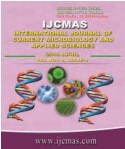


 National Academy of Agricultural Sciences (NAAS)
National Academy of Agricultural Sciences (NAAS)

|
PRINT ISSN : 2319-7692
Online ISSN : 2319-7706 Issues : 12 per year Publisher : Excellent Publishers Email : editorijcmas@gmail.com / submit@ijcmas.com Editor-in-chief: Dr.M.Prakash Index Copernicus ICV 2018: 95.39 NAAS RATING 2020: 5.38 |
Honey is one of the oldest and best loved sweetening agents for foods and over the centuries, it has still retained a “natural image”. The raw materials for the production of ‘Floral honey’ are nectar, a dilute solution of sugars found in the nectarines of the flowering plants. Henceforth, the honey is defined as the natural sweet substance produced by honeybees from the nectar of blossoms or from the secretion of living parts of plants or excretion of plant-sucking insects living on parts of plants, which honeybees collect, transform and combine with specific substances of their own, store and leave in the honey comb to ripen and mature. Honey is an easily digestible confectionary, containing a wide range of nutritiously important complementary elements. Besides having a high content of saccharides, there are also organic acids, amino acids, mineral matter, colors, aromatic substances and a trace amount of fats. Honey also contains very valuable but unstable compounds, such as enzymes, substances of hormonal character, vitamins, and few minor compounds. The medicinal use of honey in wound treatment is known, since diverse ancient civilizations. A wide range of microbial species have shown to be inhibited by honey. The aim of present study was to evaluate physico-chemical and antibacterial properties of various Apis honey from different biogeographic zones of Coorg, Western Ghats, Karnataka. The selected strains of bacteria namely – Streptococcus sp., Staphylococcus sp., Bacillus sp. and Enterococcus sp. were studied against the dilutions of honey by Agar-disc diffusion technique. The honey samples of Coorg Western Ghats, exhibited relatively high antibacterial activity.
 |
 |
 |
 |
 |